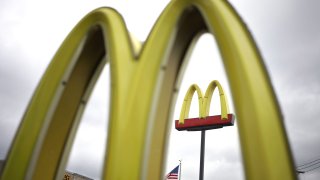
- McDonald's reported quarterly earnings and revenue that missed analysts' expectations as higher costs weighed on its profits.
- Menu price hikes that were implemented to combat rising food costs helped boost sales.
- For the full year, digital sales surpassed $18 billion.
McDonald's on Thursday reported quarterly earnings and revenue that missed analysts' expectations as higher costs weighed on its profits.
It marks the fourth earnings miss for the company in eight quarters. Shares of McDonald's fell slightly in afternoon trading.
Get South Florida local news, weather forecasts and entertainment stories to your inbox. Sign up for NBC South Florida newsletters.
Here's what the company reported for the quarter ended Dec. 31 compared with what Wall Street was expecting, based on a survey of analysts by Refinitiv:
- Earnings per share: $2.23 adjusted vs. $2.34 expected
- Revenue: $6.01 billion vs. $6.03 billion expected
The burger chain reported fourth-quarter net income of $1.64 billion, or $2.18 per share, up from $1.38 billion, or $1.84 per share, a year earlier. Excluding charges related to the sale of McD Tech Labs to IBM and other items, McDonald's earned $2.23 per share, falling short of the $2.34 per share expected by analysts surveyed by Refinitiv.
Money Report
Operating costs and expenses rose by 14% in the quarter. Those higher costs include wage hikes by McDonald's and many of its franchisees to attract and retain workers in a tough labor market. The ingredients for menu staples like its Big Macs and McNuggets are also becoming more expensive.
CFO Kevin Ozan said on the conference call that commodity and labor inflation is expected to continue in the near term. In 2022, the company is forecasting U.S. food and paper costs to rise by high single or low double digits. For comparison, those costs rose just 4% in 2021. International markets will likely also see higher food and paper costs, although not as dramatic as U.S. inflation.
The company's general and administrative expenses also rose, ticking up 9%, primarily due to higher incentive-based compensation as McDonald's exceeded its own performance expectations.
Net sales rose 13% to $6.01 billion, missing expectations of $6.03 billion. The company's same-store sales climbed 12.3% from a year ago and 10.8% on a two-year basis. Menu price hikes that were implemented to combat rising costs helped boost sales.
In McDonald's home market, same-store sales rose 7.5%, topping StreetAccount estimates of 6.9%. On a two-year basis, U.S. same-store sales climbed 13.4%. In addition to higher menu prices, the company credited its growing loyalty program and promotional menu items like the McRib for the market's strong performance. McDonald's loyalty program counts 21 million members as active users.
And while the Covid omicron variant led some of McDonald's U.S. restaurants to limit hours due to staffing shortages, CEO Chris Kempczinski said that only 1% of its domestic locations are operating with shorter hours, as of this week. More than three-quarters of U.S. restaurants have open dining rooms, helping to relieve pressure on drive-thru lanes. Kempczinski said drive-thru service times slowed in 2021, a problem that the chain is looking to rectify.
Outside the U.S., McDonald's performance was similarly strong, although some markets saw Covid-19 impact revenue. Its international developmental licensed division, which includes Japan and Latin America, reported same-store sales growth of 14.2%, crushing StreetAccount estimates of 9%. However, China reported same-store sales declines as the country faced Covid-19 resurgences in the quarter.
The company's international operated markets segment, which includes the United Kingdom, Australia and France, saw same-store sales growth of 16.8%, narrowly topping estimates of 16.5%. Australia's same-store sales were flat in the quarter as government restrictions weighed on demand.
For the full year, digital sales surpassed $18 billion, accounting for about 16% of its global systemwide sales.
Looking ahead to 2022, the company expects to spend $2.2 billion to $2.4 billion on capital expenditures. About half of that money will go toward opening more than 1,400 net new restaurants, which are expected to contribute 1.5% to the company's systemwide sales in 2022. Roughly 40% of capital expenditures will be used on the U.S. business, largely modernizing restaurants.






